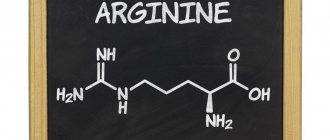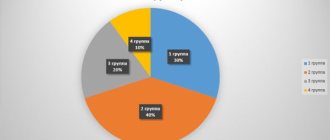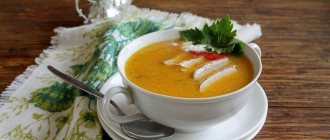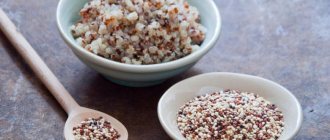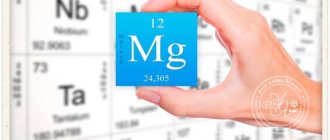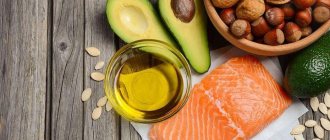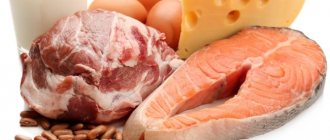Iodine is a necessary element for the normal functioning of the human body. It affects mental activity and the nervous system. In addition, it serves an important role in protecting the body. What is the danger of iodine deficiency, what foods contain it - you will find answers to these questions in the article.
The effect of iodine on the human body plays a very important role. Even from the school curriculum, this topic is very relevant. And, especially, such an impact acutely affects the health of a pregnant woman. And for this there are a number of conditional factors that are worth considering.
The effect of iodine on the thyroid gland, the relationship
In the 19th century, scientists discovered that patients with a removed thyroid gland developed cretinism. But then doctors could not even imagine that iodine is closely related to this organ and affects many processes in the body. Only after some time it was discovered in the thyroid gland, then scientists came to the conclusion that without this element it cannot fully function.
This is due to the fact that the hormones synthesized by the gland consist of more than half of iodine. They, in turn, are involved in the functioning of the brain, metabolism and other systems, so if there is a lack of iodine in the body, serious health problems arise.
Since iodine activates the functioning of the thyroid follicles, its deficiency leads to the fact that the function of this organ weakens over time. It is important that the body receives the amount of the substance it needs every day.
Eating only foods that do not contain iodine leads to the development of serious diseases.
However, an excess of this microelement negatively affects both the thyroid gland itself and the entire body as a whole. This can lead to the onset of inflammatory processes in internal organs, eye diseases and hepatitis.
Endocrine disorders most often affect women during pregnancy. At this time, they develop gestational hypothyroidism, which is why the consulting gynecologist prescribes taking “Iodomarin” or other similar complex-action drugs for the full development of the child and the health of the mother.
Regular consumption of iodine during pregnancy prevents mental and physical abnormalities in the newborn.
Foods with medium content I
The list of products with an average concentration of iodine per 100 g - from 5 to 25 mcg - is presented in the table:
| Who are the products recommended for? | Grocery list |
| The products are indicated for use in order to correct the increased concentration of iodine in the body. |
|
Iodine standards per day for different population groups
Mainly, the iodine requirement is determined based on the age and weight of the person.
The average normal daily intake of this element by the human body is:
- for older people – 100 mcg;
- for adults and adolescents – 150-200 mcg;
- for pregnant and lactating women – 250-300 mcg;
- for children 7-12 years old – 120-150 mcg;
- for children 2-6 years old – 90-130 mcg;
- for children under one year – 50-90 mcg.
However, the region of residence also matters in this case. The daily requirement of iodine for adults living in coastal areas is less, since they receive it from the air.
How to determine the iodine content in the body?
It is very important to diagnose iodine deficiency in the body as early as possible. Suspicion of abnormalities may be based on the corresponding symptoms. In addition, the endocrinologist performs a visual examination and palpation of the thyroid gland. In some cases, an ultrasound examination is prescribed.
You can check the level of this microelement by passing the appropriate tests at the clinic, a referral for which is given by an endocrinologist.
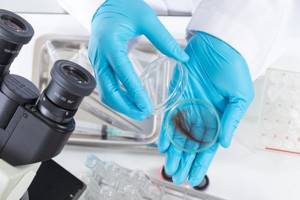
The following can be used as biomaterial:
- patient's nails;
- hair;
- urine.
Tests are the most accurate method for determining iodine content in the body.
However, there are also home methods for diagnosing this problem, but their results cannot be called sufficiently accurate. To independently determine the deficiency of the element in the body, before going to bed, apply three strips of 2, 3 and 6 cm in length to the forearm with a cotton swab with iodine, and in the morning carry out an analysis based on the results obtained:
- the shortest band has disappeared – there is no problem of microelement deficiency;
- two small stripes have disappeared - it is necessary to introduce more iodine-containing products into the diet;
- All three bands have disappeared - this is a symptom of a progressive deficiency that needs treatment.
There is another simple way to determine the lack of iodine in the body. It consists of drawing an iodine grid on the foot at night with a cell pitch of 1 cm. In the morning, after waking up, the foot needs to be examined. The less pronounced the pattern becomes, the greater the deficiency of the substance the body experiences. If there are no deviations, the trace of iodine should persist for 24 hours.
Symptoms of deficiency
Products that do not contain iodine and are consumed systematically as the basis of the diet can cause microelement deficiency. Its deficiency affects both sexes equally.

The main signs of iodine deficiency are:
- increased volume of the thyroid gland;
- poor performance, lethargy and apathy;
- memory impairment;
- presence of swelling;
- rapid weight gain while the diet remains the same;
- deterioration of hair and nails;
- the appearance of shortness of breath;
- pain in the heart area;
- hearing impairment.
Symptoms of excess
Excess iodine in humans provokes hormonal imbalance and the development of hyperthyroidism. The concentration of thyroid-stimulating compounds in the body increases, as a result of which peripheral nerves, blood vessels, and the heart are affected, which leads to the following symptoms:
- cardiopalmus;
- myocardial infarction;
- problems in the central nervous system;
- hypertension;
- cardiac arrhythmia.
A characteristic sign of oversaturation of a man’s body with iodine is a decrease in potency. Against the background of disturbed hormonal balance, erection disappears and sexual dysfunction develops. A man cannot be sexually active and, accordingly, have children.

In women, hyperthyroidism is manifested by increased activity of the thyroid gland, which leads to serious disturbances in the menstrual cycle and decreased libido. Metabolism, on the contrary, accelerates.
This can adversely affect the condition of a pregnant woman and cause miscarriage or premature birth, and in some cases leads to disturbances in embryonic development and damage to the central nervous system of the newborn.
If there is an excess of iodine in children, a sore throat and irritation of the mucous tissue may occur. The eyes are the first to suffer, with blepharitis and inflammation of the conjunctiva developing. In its advanced form, the disease develops into cataracts.
In case of severe iodine poisoning, symptoms appear in the coming minutes and are expressed by the following manifestations:
- lacrimation;
- skin rashes;
- hard breath;
- temperature increase;
- metallic taste in the mouth;
- formation of ulcers in the oral mucosa;
- discomfort or pain in the nasopharynx;
- general weakness;
- dizziness.
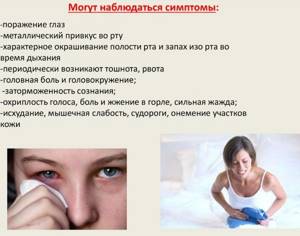
When the first signs of poisoning appear, you must immediately call an ambulance and take the patient to the hospital, where he will be under 24-hour medical supervision. Such consequences can be avoided by strictly observing the dosage of iodine-containing medications.
What's the salt in this?
When choosing salt, its taste plays an important role. That’s why different types of salt are so popular today – salt with added spices, coarse sea salt, black Thursday salt or pink Hawaiian salt. However, from a health point of view, the only important thing is how much salt a person consumes and whether it contains iodine.
Experts strongly recommend putting only iodized salt on your plate. But not all salt that is sold with the appropriate mark on the package can be called as such.
Experts from Roskontrol took 6 samples of iodized salt for testing. It was necessary to find out whether the products met the national standard for iodine content and the declared variety.
In fact, according to the legislation of the Russian Federation, salt to which even a minimal amount of iodine has been added can be considered “iodized”. The technical regulations prescribe that it should be added to the composition in an amount of “no more than 40 mcg/g.” However, minimal doses of the beneficial substance do not provide salt with preventive properties. Therefore, experts initiate the introduction of appropriate changes to technical regulations.
Of the six tested salt samples, according to the requirements of the standard, only two products can be considered iodized: “Rusi Salt” iodized table “Extra” grade and Setra iodized sea salt of the highest grade.
General rules
Radioiodine therapy treats diffuse toxic goiter and other forms of toxic goiter - toxic adenoma , multinodular and nodular toxic goiter , which are classified as functional autonomy of the gland. The goal of treatment is complete destruction of its tissue.
The radioactive drug is taken in solution or capsules, and the gland tissue absorbs it well. Radioiodine destroys gland cells, first causing necrosis and an inflammatory reaction. Over time, as a result of inflammation and fibrosis, the size of the gland decreases and hypothyroidism . Most patients become euthyroid. Due to 131I deficiency, this method is rarely used in the treatment of patients with thyrotoxicosis .
More often it is used in the treatment of papillary and follicular thyroid cancer as an independent method and after surgical treatment. The combined treatment method gives good results - in 80% of cases, cancer is cured. As radioactive iodine decays, it produces beta particles , gamma radiation , and xenon . Under the influence of beta radiation, local irradiation occurs and cancer cells that have accumulated iodine are destroyed. In this case, the surrounding tissues are not damaged.
Gamma radiation helps in the diagnostic process after surgery. If the thyroid gland is removed, then detection of foci of absorption by other organs (lymph nodes or lungs) helps determine the extent of the process and distant metastases . This helps to choose the right tactics for patient management in the future.
We recommend reading: High estradiol in women: causes, signs, methods of reduction and possible complications
Before the procedure, preparation is necessary. First of all, stop taking Thyroxine or Euthyrox . The lack of replacement therapy may result in fatigue and drowsiness , but is easily tolerated by the patient. During the preparation period, you should also not take Iodomarin , Potassium iodide , Iodaktiv , complex vitamins and cardiac drugs - Cordarone ( amiodarone ). Do not use a solution of iodine or lyugol .
The abolition of all iodine-containing drugs improves the ability of the gland to subsequently capture radioactive iodine. After 3-4 weeks of withdrawal, iodine “starvation” occurs and cancer cells begin to actively capture the injected radioactive iodine, which is harmful to them. The more active the capture occurs, the more effective the destruction process.
An iodine-free diet before treatment with radioactive iodine is the second condition for increasing the effectiveness of treatment. The principle of action is based on the maximum absorption of iodine by cancer cells. If the iron is saturated with ordinary iodine, then the capture of isotopes does not occur or does not occur enough to obtain a therapeutic effect.
This diet is not strict, and patients do not feel discomfort or lack of nutrition. An iodine-free diet involves excluding foods high in iodine, iodized salt and sea salt from the diet. Let us remind you that the norm of iodine consumption for a healthy person is 150-200 mcg. In this case, the dose should not be higher than 40-50 mcg per day and this will be enough for effective treatment.
To comply with this condition, you need to exclude foods with a high content of it (this is 20 mcg per serving). Products with a moderate content (5-20 mcg) are included in the diet in a limited manner, and those with a low level (less than 5 mcg) are included without restrictions.
Before treatment with radioactive iodine, the following are excluded:
- sea fish, seafood and sushi;
- algae in natural form or in the form of additives;
- dairy products (sour cream, cheeses, butter, yogurt, ice cream, dry cream, whey, milk, all fermented milk products, products with casein);
- egg yolk (only the white is used);
- milk chocolate;
- industrial products with agar-agar;
- preparations and additives with Irish moss, carginan and alginates;
- products and tablets of red and orange color (they use iodine-containing dye);
- soybeans, its products and red beans;
- green leafy vegetables and garden herbs;
- feijoa and persimmon;
- iodized and sea salt;
- salted nuts and chips (it is possible that iodized salt was used in their preparation);
- baked goods and confectionery products made from dough with iodate (pay attention to the composition);
- dried fruits, except raisins.
Of course, during this period you should not eat in cafes and restaurants. You need to cook at home using approved products and not eat processed foods. The duration of such nutrition is 2-3 weeks, throughout the duration of treatment and 2 days after its completion.
Repeated treatment with this method may be necessary if not all thyroid cells are destroyed. Repeated treatment is safe but requires the same preparation. There is always a risk of tumor recurrence, so it is necessary to conduct regular examinations (especially 5-7 years after surgery). It consists of determining thyroglobulin in the blood (a specific marker of papillary or follicular cancer cells), performing an ultrasound of the neck and chest x-ray.
Scintigraphy (which uses radioiodine in a diagnostic dose) can also detect cancer recurrence. The whole body is scanned in a special camera, and lesions are identified on the scanogram.
During pregnancy or suspected pregnancy, this type of treatment is contraindicated. After treatment, suppression of the function of the gonads ( menstrual and oligospermia ) may occur.
Six months to a year after treatment, a woman can plan a pregnancy. In this case, there must be complete confidence that there is no need for repeated treatment with this method. A man should not plan to have children for 4 months.
Summarize
- People with thyroid cancer are often prescribed an iodine-free diet to increase the effectiveness of their upcoming radioactive iodine treatment.
- This short-term diet is very strict and usually begins 1-2 weeks before therapy and continues for several days after. However, exact recommendations may vary depending on the person and your doctor.
- Although this diet is restrictive, there are many healthy eating options and ideas to consider, such as those presented in the sample menu above.
Tags: Iodine-free diet, Thyroid health, Iodine
- Related Posts
- What is the Budwig diet and does it prevent cancer?
- 23 best hangover products
- What can you eat if you have chickenpox, and what can you not?
« Previous entry
Prohibited foods (very high iodine content): list
Avoid the following foods on a low iodine diet:
- Dairy products (milk, yogurt, cheese, butter, ice cream, sour cream)
- Egg yolks
- Seafood (anything from the ocean should be avoided, including fish, shellfish and seaweed)
- Processed foods (pre-packaged frozen foods, deli meats, hot dogs, bacon, sausage, restaurant and fast food items)
- Store-bought bakery products (bread and all confectionery products)
- Soy (including soybeans, soy sauce, tofu and any other soy products)
- Chocolate (milk chocolate contains dairy, although some dark chocolate may be allowed)
- Beans (especially red beans).
What else is allowed?
But that's not all. Other products are also allowed for consumption. You can diversify the menu with blueberry muffins, pancakes, and fried vegetables. You can also add vegetable soups to your diet. You can prepare different vegetable salads every day. Drinks can also be varied with different compotes, jelly with different flavors, and various herbal teas. It is necessary to limit your consumption of meat. After a diet course, a repeat course may be needed. This proves that not all cells were destroyed. In this case, consultation with a specialist is necessary.
It is important to remember that the diet lasts a short period of time. When following a diet, it is advisable to eat food only at home, since some restaurants, cafes, and canteens may add foods to food that should not be consumed. You also need to count the calorie content of the food you eat. It is calculated based on a person’s weight, age and health. The body tolerates the diet normally, because it receives all the necessary substances and vitamins in sufficient quantities. At the same time, the recovery process proceeds quite quickly. Unauthorized use of the diet is strictly prohibited. It must be remembered that the iodine-free diet is primarily a therapeutic diet, and not a regular diet for weight loss. Its main advantage is that with its help a person can get rid of many diseases. The diet is not recommended for healthy people.

What foods do not contain iodine?
The following foods do not contain iodine or do contain it, but in very small quantities, so they can be consumed in any quantity :
- Fresh fruits (bananas, grapefruit, cranberries, oranges, tangerines, seedless apples, pears, currants)
- Fresh juices , excluding rhubarb, maraschino cherries and fruit cocktails containing maraschino cherries.
- Vegetables , preferably raw and freshly cooked or frozen without salt. (You should not eat potato skins, soybeans and some other legumes: variegated beans, lima beans, navy and red beans, cowpeas).
- Unsalted nuts (peanuts, almonds) and unsalted nut butters.
- Sugar , jelly, honey, white marshmallows, maple syrup, unsulfured black molasses.
- Seasonings : Black pepper and fresh or dried herbs.
- All vegetable oils . Salad dressings containing only approved ingredients.
- Drinks : instant coffee, tea, beer, wine, other alcoholic drinks.
- Egg whites and products based on them (meringues, meringues, egg white omelettes, etc.)
You can also eat foods that contain little iodine (the average amount of iodine is from 5 to 20 mcg), but their consumption is necessary for a complete intake of all necessary vitamins and minerals.
- Fresh meat . You can consume up to 140 g per day of fresh chicken, beef, pork, lamb or veal. 450 g of meat contains 25-130 mcg of iodine. A whole piece of meat contains less iodine than minced meat.
- Cereals and cereals . You can eat up to 4 servings of cereals, cereals, pasta and bread that do not contain iodine. The iodine content depends on the region where the cereals are grown.
Dietary rules for iodine deficiency and increased concentration
If there is a pronounced imbalance of iodine content in the body in one direction or another, which is confirmed by laboratory tests, an endocrinologist can prescribe supportive drug therapy, as well as appropriate diets.
The rules for creating a diet for iodine deficiency provide for increased consumption of foods high in this element - about 90% of the entire daily menu.
Products should be semi-cooked or raw, carbohydrate intake should be reduced and the amount of proteins and vitamins in dishes should be increased. Iodized salt must be present in the menu; its use eliminates overdose; a sufficient daily dose of such salt is 10 g.
Products low in the substance or not containing iodine should form the basis of the diet - this is the main rule for forming a diet with excess iodine in the body, and the second option is the most preferable.
The goal of such a diet is to reduce the daily consumption of this element to an average of 50 mcg; it is also recommended to use salt that is not fortified with iodine, and exclude sea fish and seafood from the menu. The consumption of river fish and animal meat is allowed in small quantities - about 150 g per day.
Cereals are included in the diet based on the iodine content in them. For example, if you eat oatmeal today, then the next day you need to prepare buckwheat, it contains less iodine. Pasta products should not contain yolks; it is prohibited to consume potato peels, soybeans and legumes.
For the treatment of diffuse and other forms of toxic goiter, as well as after surgery, radioiodine therapy may be prescribed, which involves following a short-term diet with a low iodine content in dishes and products.
Such therapy is prescribed exclusively by an endocrinologist and cannot be used on an independent decision. The daily iodine intake in this case should not exceed 4-5 mg.
The scheme is as follows:
- The duration of the diet before the examination is 2 weeks.
- The restrictions then continue for another 2-3 weeks during treatment.
- At the end of therapy, the diet is followed for another 2-5 days.
What is an iodine-free diet?
Before radioiodine therapy, special preparation is required. It consists of canceling replacement therapy with Thyroxine or Euthyrox and following an iodine-free diet. The method of preparing a patient for exposure to radioactive iodine was developed by an honored endocrinologist, Ph.D. Fetisova N.V. (Saint Petersburg). Tests and studies have shown that a diet low in iodine thoroughly prepares the patient's body for intensive care and does not have a negative effect on his condition.
Significantly reducing the consumption of iodine-containing foods and medications increases the thyroid gland's ability to take up radioactive iodine. After 3–4 weeks of an iodine-free diet, an acute iodine deficiency occurs in the body; against this background, gland cells and cancer cells begin to intensively absorb the injected radioactive iodine. The more active the uptake of iodine, the better the process of destruction of cancer cells.
- How to attract luck and money into your home, into your life
- Oat bran - benefits and harm. How to take oat bran for weight loss and cleansing the body
- List of antibacterial nasal drops for children and adults
We recommend reading: The hormone glucagon: where it is produced, functions and mechanism of action
An iodine-free diet is used exclusively for therapeutic purposes and is prescribed by the attending physician for each patient individually. Under no circumstances should you use a low-iodine diet on your own to treat thyroid diseases. Due to the imbalance of mineral balance, the use of such a diet for healthy people is dangerous.
Recommended
Recommendations for those following this diet:
- Maintain proper nutrition.
- Eat foods low in iodine.
- Consultation with a doctor.
- It is advisable to avoid eating outside the home.
- Calculate the calorie content of ingredients.
- Create the right menu for each day.
- The duration of the diet is no more than 3-4 weeks.
- It is better to cook bread, noodles, and pasta at home.
- You should not eat semi-finished, canned or fast food products.
- Warn your doctor about the medications you are taking immediately before the diet.
- All dishes are prepared at home.
- Strictly follow all instructions.
Reviews from people who have tried this diet say that it has a fairly positive effect on health and the entire body as a whole. If you follow all the recommendations, the result will be quick. But before starting the process, consultation with a specialist is necessary.
Diet rules
The basic principle of a preparatory iodine-free diet is avoidance of foods and medications high in iodine. The daily iodine intake for a healthy person is 150–200 mcg. For effective treatment, the dose should not exceed 40–50 mcg. During an iodine-free diet, foods high in iodine (20 mcg per serving) are excluded, foods with a low content (5–20 mcg) are limited, and foods without (less than 5 mcg) iodine are allowed indefinitely. Prohibited products include:
- sea, iodized salt;
- sea fish, seafood, seaweed (nori, seaweed), crabs, crab sticks, algae-based products (agar-agar, alginates, carginan);
- milk, dairy products, casein;
- egg yolk and any dishes containing it;
- soybeans, soy products (milk, sauces, tofu);
- red and bright varieties of beans;
- milk chocolate, marmalade, marshmallows, soufflé with agar-agar, candies with dry egg powder or powdered milk;
- any greens (parsley, dill, rhubarb, salads), green peppers, cauliflower, zucchini, olives;
- cherries, persimmons, dried apricots, prunes, feijoa, bananas;
- chips, salted nuts, instant coffee, sausages, canned meat, mayonnaise, ketchup;
- bakery products, which may contain iodized salt and potassium iodate (E917);
- finished products are orange, red or red-brown in color. These colors are given to them by the iodine-containing dye erythrosine (E127);
- multivitamins and nutritional supplements containing iodine, Lugol's solution, preparations for iodine therapy;
- dietary supplements containing alginate and Irish moss.
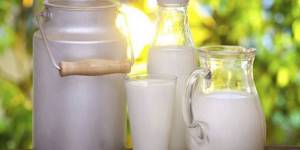
Highly iodized products
A list of foods that have a high iodine concentration is presented in the table:
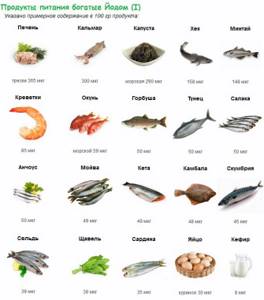
| Who are the products recommended for? | List of products |
| The products are indicated for people with hypothyroidism, a dysfunction of the thyroid gland that leads to a decrease in iodine levels in the body. |
|
Sample menu for 14 days
Using the above recipes and using this table, you can create your own menu for the entire duration of the diet:
| Breakfast | Dinner | Dinner | |
| Day 1 | Hot oatmeal or wheat porridge with honey or brown sugar. Fresh fruits. Coffee or tea with lemon. | Place fried garlic in olive oil on salt-free rice cakes, crackers or crackers. Homemade soup (such as chicken or vegetable). | Fruits, Marshmallows, homemade popcorn |
| Day 2 | Scrambled eggs made only from egg whites in vegetable oil, fried vegetables. Toast or rice crackers. | Homemade beef or vegetable stew | Popsicles (made from 100% juice) Raw vegetables |
| Day 3 | Fruit smoothie (fresh fruit mixed together). Pancakes (homemade) or dry cereal. Coffee or tea with lemon. | Home fried chicken. Fried potatoes or rice with olive oil. Stewed vegetables or homemade vegetable stir fry. | Fresh fruit + water/juice/homemade green iced tea |
| Day 4 | Homemade muffins or toast/crackers with jam or peanut butter. Fruits. Coffee or tea with lemon. | Dark chocolate (dairy, salt and soy free) Homemade sorbet (frozen fruit puree) | |
| Day 5 | Salad with homemade dressing Sandwich of iodine-free bread with roasted vegetables, peanut butter and jam, Homemade sliced beef or chicken. Avocado puree can be used as a substitute for mayonnaise. | Salad with homemade dressing Pasta and meatballs/meat sauce made with homemade tomato sauce or pasta with pesto sauce. | Homemade pie or muffins + water, juice/coffee/tea. Oatmeal cookies, almonds or coconut macaroons). Raw vegetables. Marshmallow. |
Sources:
- https://healthperfect.ru/produkty-ne-soderzhaschie-yod.html
- https://medside.ru/bezyodovaya-dieta-pered-radioyodterapiey
- https://cosmoreviews.club/polsa-i-vred/63-produkty-bez-yoda-spisok-i-menyu-pered-radioyodterapiey.html
- https://heaclub.ru/produkty-pitaniya-soderzhashhie-i-jod-dlya-shhitovidnoj-zhelezy-spisok-tablica-v-kakih-produktah-vysokoe-i-nizkoe-soderzhanie-joda-tablica-nedostatok-nehvatka- deficit-joda-i-izbytok-v-organizm
- https://ktoikak.com/kakie-produktyi-ne-soderzhat-yod/
- https://sovets.net/18646-bezjodovaya-dieta-menyu.html
